In 1704, Isaac Newton penned Opticks, an exploration of the science of how light affects how we see color. While Newton wasn’t the first to talk about the subject it was a defining moment, the formalization of what would later come to be known as “color theory”.
For centuries, the center of color theory was the color wheel. And the center of the color wheel was the color white, the absence of color. Add to that red, blue, or yellow, and you have your primary colors—the RYB model. Mixing those together produces secondary colors—violet, green, and orange. And mixing those secondary colors produces tertiary colors. It was an imperfect system, as it couldn’t produce every color that was visible to the human eye, but the further you went—mixing tertiary colors to produce new colors and then mixing those and then mixing the next, etc.—the closer you got. For centuries, this model served us well.
Then modern day technology came along and changed the way we think about color. Printing using the old RYB model wasn’t feasible. The darker the color, the more ink would be needed to achieve it, adding extra cost, and also weighing the paper down with a lot of ink that would need time to dry and, as a result, could potentially smudge. And thus, the CMYK model—cyan, magenta, yellow, and key (black)—and, eventually, Chroma Mix, the subject of this review, was born.
Of course, this is an oversimplification of color theory and its origins and I have taken a few artistic liberties to avoid getting too far into the weeds. For instance, I didn’t even talk about complementary colors, the origin of the word ‘key’, or the difference between additive and subtractive models. Suffice to say, there’s a lot to talk about and it’s worth looking into if you’re curious.
According to designer Jorge Zhang, it was that same curiosity that inspired Chroma Mix in the first place.
Overview
As you’ve no doubt surmised, Chroma Mix is a game about color. More specifically, it’s an engine builder with a dash of hand management thrown in. Players begin the game with just a few basic cards. Each can be played for its ability or can be utilized for its color using the mix action. Mixing allows the players to combine two colors in order to purchase a different color from the market row, of which there are four Ranks. The first Rank consists of the basic cards. The second is composed of slightly better ones. The third, even better cards. And the fourth contains three end-of-game scoring cards. These cards, once purchased and played, will bring the game to an end once one of the players that played them meet the card’s criteria.
And, no, you’re not hallucinating. You read that right. Chroma Mix has three distinctly different ways to bring the game to an end, three different paths the players can follow. Do they gun for one specifically, or do they hedge their bets and try to work on several at once? And what path do they follow to get there?
Good questions. Let’s talk about how a game of Chroma Mix is played and see if we can’t answer them, shall we? Or, if you’re just interested in what I think, feel free to skip ahead to the Thoughts section.
Setup
A game of Chroma Mix is setup thusly:
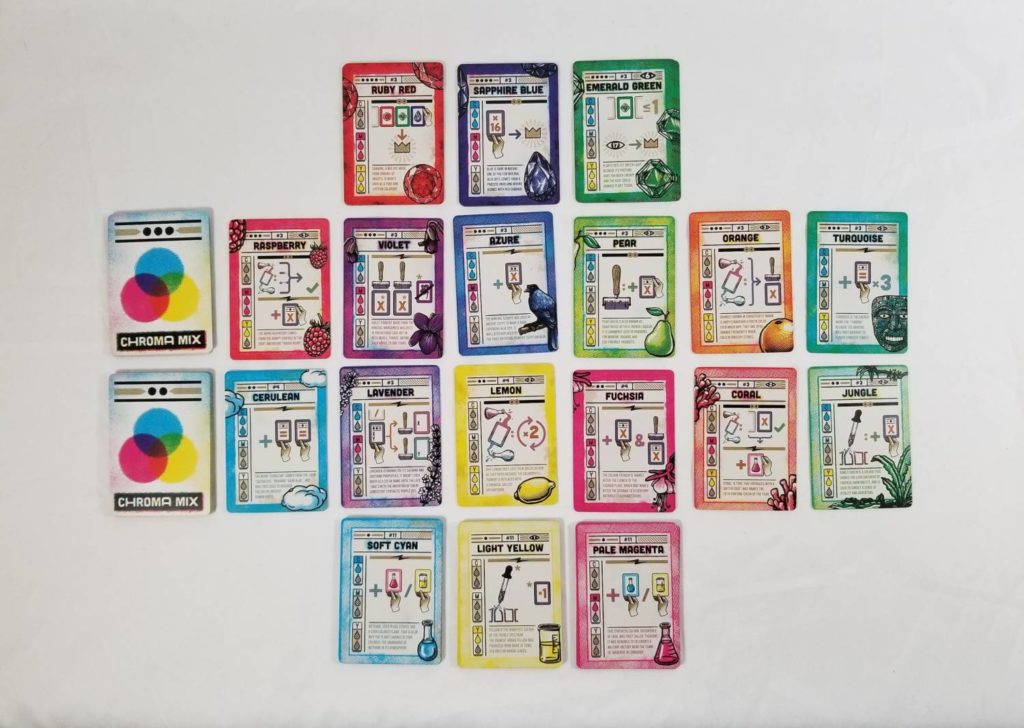
First, the deck of cards is divided into its four distinct Ranks. The Rank 1 and Rank 4 cards are separated by type. The Rank 2s and 3s are each shuffled into their own decks. Then, a tableau is formed. The Rank 1 cards are at the bottom of the tableau. Above this is a row of six randomly drawn Rank 2 cards. Above that is a row of six randomly drawn Rank 3 cards. And above that are the three stacks of Rank 4 cards. The deck of Rank 2 and 3 cards are set, face down, to the left of the appropriate rows.
Then, each player receives one each of the Rank 1 cards—cyan, pale magenta, and light yellow. Next, a start player is determined by some means and you’re ready to begin. As far as game setups go, this is one of the easiest you’re likely to encounter.
Anatomy of a Card
Despite their gameplay differences, each card shares the same layout and it’s important to internalize the information being provided in order to fully comprehend how the game is played.
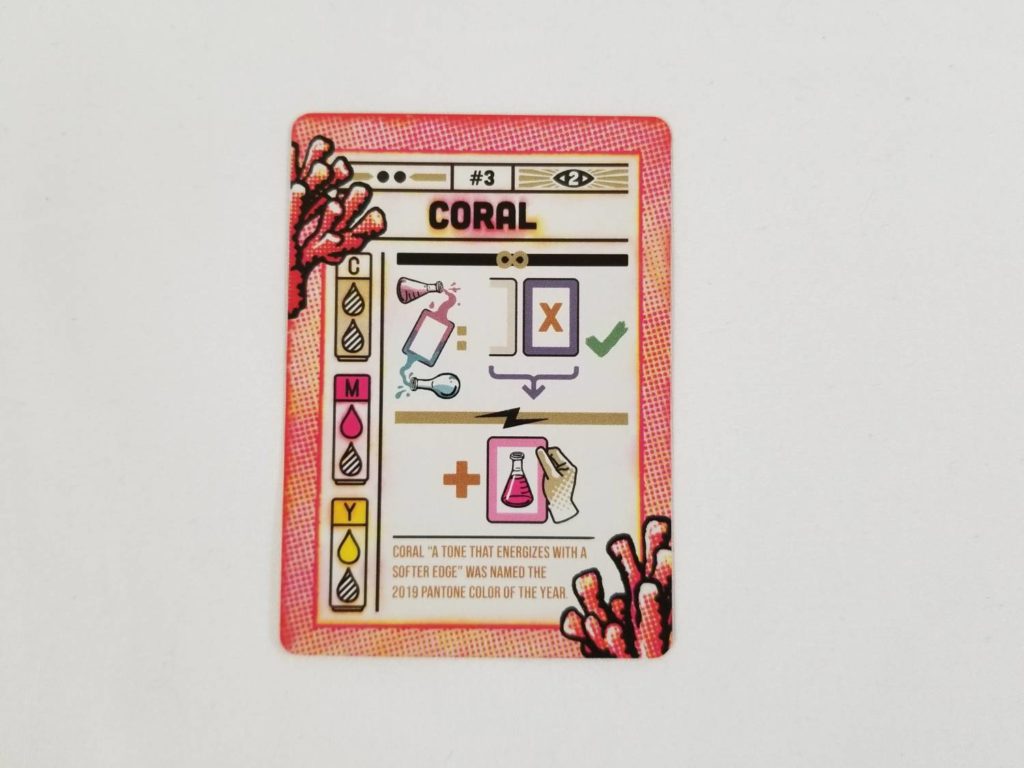
At the top of the card, from left to right, we have a number of black dots (indicating the card’s Rank), a number (indicating how many copies of this card are in the game overall, and an icon with a number (indicating how many points the card is worth when it is played into your playing area, if any). Directly beneath this is the name of the color the card represents.
On the left side of the card, we have a column showing three groupings of two droplets, each grouping labeled with a letter (C, M, and Y). Some droplets are shaded in while others are filled with color. The droplets filled in with color indicate which other colors are combined to form the color represented by the card. This also indicates which colors the card provides when it is combined with other cards.
To the right of this is some iconography that illustrates what the card actually does once it is played from your hand into your playing area. Some effects are instantaneous. Others are ongoing, providing their benefits whenever specific triggers are met. Others offer some mixture of both.
At the bottom of the card is an icon unique to that color, as well as a fun fact about the color. The icon is one of the game’s best features. It made me wonder how colorblind-friendly Chroma Mix is, an important consideration in a game about color. So, I installed a colorblind simulation app on my phone and took a look at the various cards through that lens. Much to my surprise, regardless of which type of colorblindness I simulated, I had no trouble distinguishing between the different cards. I love this. Hats off to graphic designer Nikolaj Cyon for nailing this aspect.
The Four Actions
Chroma Mix uses three thematically titled actions (and one not-so thematic one) to keep the momentum going.
Printing is the act of playing a card from your hand into your play area. Any instant effects occur the moment the card enters play. Any ongoing effects go into effect at this time as well. As mentioned previously, some cards have both.
Mixing cards is how the players obtain cards of higher Ranks. As mentioned previously, every card has a column running along its left hand side which describes the colors needed to obtain the card. So, to obtain a card like Raspberry, which requires two magenta and one yellow, you could mix (return the card from your hand to the appropriate discard pile) a Coral (MY) with a Magenta (M) OR you could mix a Fuchsia (MM) with a Light Yellow (Y). But you cannot overmix—mixing Lemon (YY) and Fuchsia (MM), for instance—as doing so would create some color other than Raspberry. The newly obtained card is then placed into your hand where it is free to be printed or mixed with another card on a future turn.
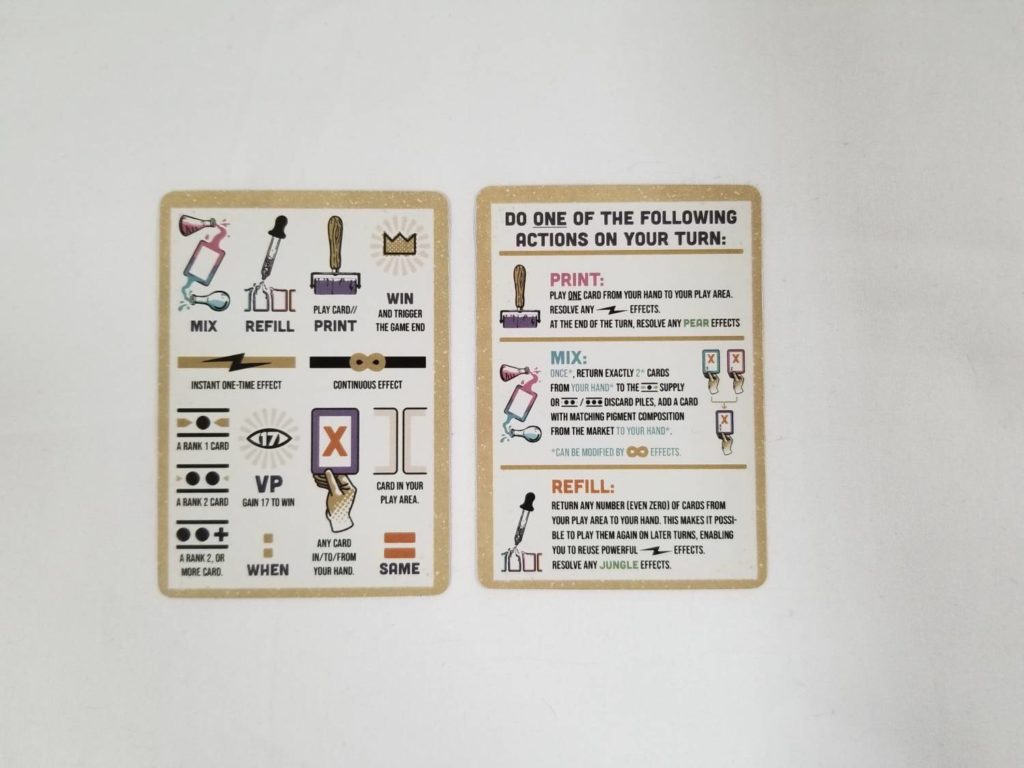
Refilling allows you to return cards from your play area to your hand. This allows the card to be printed or mixed with other cards in future turns. However, it is worth noting that some cards have victory point values when they’re in play and returning these cards to your hand will lower your current running victory point total.
Swapping allows you to ditch a card from your hand to pick up a Rank 1 card of your choice. It’s inefficient, but it’s sometimes necessary if you’ve mixed one too many times and find yourself at an impasse.
The Three Victories
Chroma Mix can end in one of three ways (or possibly, even all three!).
The first type of victory is the Ruby Red (MMYY) victory. If this card is in a player’s play area and they also have a Sapphire and an Emerald in play or in their hand, they win the game at the end of the round in which the condition was met.
The second type of victory is the Sapphire Blue (CCMM) victory. If this card is in a player’s play area and they have at least sixteen cards in their hand, they win the game at the end of the round in which the condition was met.

The third type of victory is the victory points victory. If a player has at least seventeen points worth of cards in their play area, they win the game at the end of the round in which the condition was met. Emerald Green (CCYY) is useful for achieving this, since it provides six victory points, but it’s not necessary.
Every player gets the same number of turns. So, if the first player triggers the end game on their turn, the other players still get to take their turns. Therefore, it is possible for all three end game conditions to be triggered by different players in the same round. Should this happen, there are tie breaker rules in place: ruby, most cards in hand, vp, and reverse turn order (in that order).
Thoughts
Sleek.
That’s the word that popped into my head when I opened Chroma Mix for the first time.
Packaged inside of a glue-free, single-piece construction tuckbox, illustrated in a style that almost appears to be stamped on, Chroma Mix screams ‘print shop chic’. It’s the type of game you could see your buddy cranking out by hand on the printing press in his shop, assuming your buddy does this kind of thing for a living and has a real flair for it.
This game looks freakin’ cool is what I’m saying.
Nestled within this unassuming packaging is a game which resembles games that have come before, while still managing to feel fresh and new. The way that the various cards are mixed together in order to progress upwards through the card Ranks is redolent of games like Gizmos. The way that each card obtained makes it easier for the player to obtain the next smacks of Splendor. But in both of those games, your tableau is stagnant. Once a card has been placed, it remains there performing its function for the remainder of the game. The genius of Chroma Mix is that you’re constantly asked to make tough decisions, sacrificing something useful in order to gain something else. Do you keep that useful ability in play or do you perform a refill in order to return it to your hand so it can be mixed to pick up something else altogether?
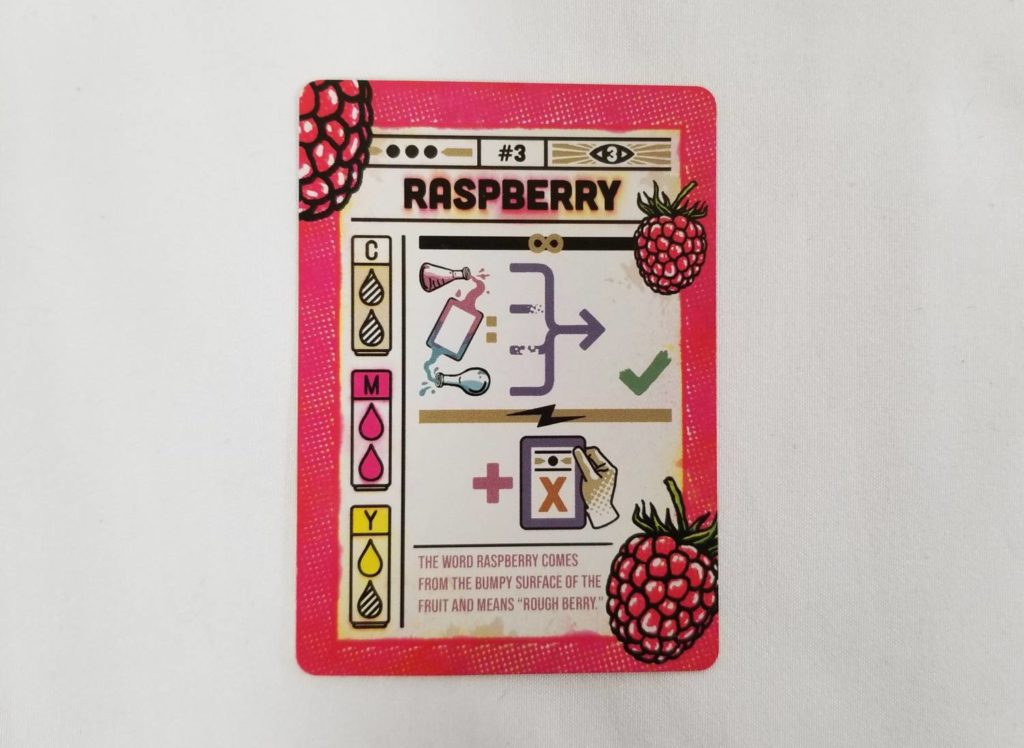
These decisions are made even tougher when you consider the abilities you’re giving up. Consider the Rank 3 card Raspberry (MMY), for instance. Raspberry allows you to mix using any number of cards from your hand instead of just two. That’s incredibly useful. Yet, at the same time, Raspberry makes up three of the required four pigments needed to pick up a Rank 4 Ruby Red (MMYY). So, mixing a Raspberry and a Light Yellow seems like a no-brainer. That is, until you consider that pulling off a Ruby Red victory requires you to also have an Emerald Green and Sapphire Blue in your possession, each of which is much easier to pull off if you’ve got a Raspberry in play. I love games which feature such rich decision spaces, and Chroma Mix does this very well.
What I’m not in love with are the fun facts. More specifically, I’m not thrilled with where they’re located. The back of the rule book includes an appendix that describes what each of the different cards do. What I wish is that the fun facts about the various colors were in the appendix and the text describing the iconography was on the cards themselves. As it is, in each game I’ve played, the players spend a great deal of time passing the rules booklet around trying to figure out what the various cards in the market rows actually do. I’m not sure why this decision was made, but it is my fervent hope that this is fixed before Chroma Mix’s final publication.
The task of looking up the cards is further confused by how the cards are presented in the appendix. Other than being separated by their different Ranks, there’s no discernible rhyme or reason to how they’re arranged. You might think they’d be in alphabetical order, but you’d be wrong. Cerulean, for instance, is sandwiched between Lemon and Jungle. I hope this is resolved as well.
And, honestly, those are about the only negative things that I have to say about this surprisingly challenging and enjoyable game. Designer Jorge Zhang has packed a lot of game into this tiny package. Chroma Mix looks fantastic, the mechanics are super easy to internalize, and the decision space is rich and interesting. There’s even a super simple, easy to manage solo mode included. At a price point of just $17 USD, that’s a steal!


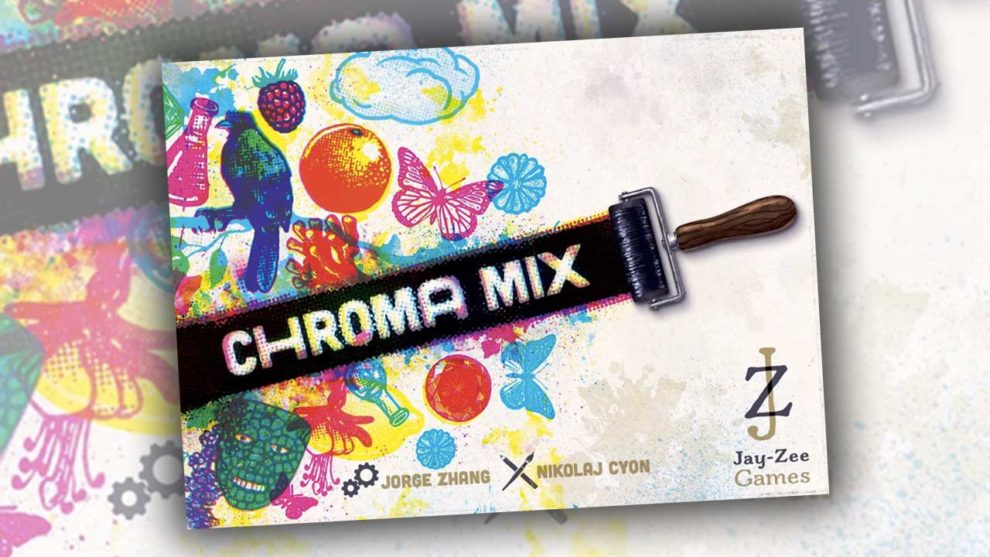


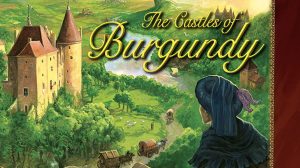





Add Comment